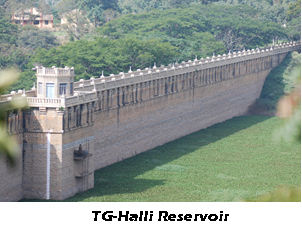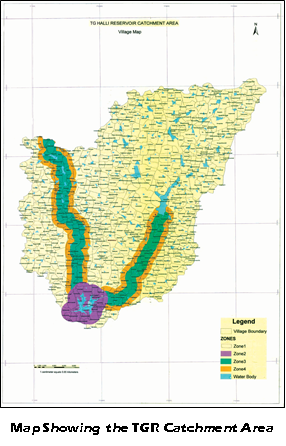Title: Comprehensive Assessment of Thippagondanahalli Reservoir Catchment Area and its Preservation Zone
Year of Publication: 2015
Published by: Environmental Management and Policy Research Institute
Printed Year: 2015
Details:
Comprehensive Assessment of Thippagondanahalli Reservoir Catchment Area and its Preservation Zone
 As a conservation measure to protect the Thippagondanahalli Reservoir catchment area measuring 1453 sq.km, the Department of Ecology and Environment, Government of Karnataka issued a Government Order under section 5 of the Environment (Protection) Act, 1986, dated 18th November 2003, by declaring the entire catchment area as ecologically sensitive, classifying into four zones and prohibiting different types of development activities in the catchment area. Accordingly, to study the current status of Thippagondanahalli Reservoir the Department of Ecology and Environment entrusted the study to EMPRI with three terms of reference (TOR). Subsequently, in connection to this study the Hon’ble High Court of Karnataka accorded additional ten terms of reference and directed EMPRI to carry out a comprehensive study and submit the interim report on 27th April, 2015.
As a conservation measure to protect the Thippagondanahalli Reservoir catchment area measuring 1453 sq.km, the Department of Ecology and Environment, Government of Karnataka issued a Government Order under section 5 of the Environment (Protection) Act, 1986, dated 18th November 2003, by declaring the entire catchment area as ecologically sensitive, classifying into four zones and prohibiting different types of development activities in the catchment area. Accordingly, to study the current status of Thippagondanahalli Reservoir the Department of Ecology and Environment entrusted the study to EMPRI with three terms of reference (TOR). Subsequently, in connection to this study the Hon’ble High Court of Karnataka accorded additional ten terms of reference and directed EMPRI to carry out a comprehensive study and submit the interim report on 27th April, 2015.
 According to the terms of reference the field visits were carried out by the researchers to understand the present status of the catchment area, developments that have taken place and for identifying the sources of pollution. Remote sensing and GIS analysis has also been carried out to find out the change in land use/ land cover. The properties concerning the Writ Petitions have also been visited and observations recorded along with photographs and GPS readings. Water quality has also been analysed by collecting samples. Both the Rivers Arkavathi and Kumudvathi are non-perennial and major water flow is seen only during monsoon. During summer the Arkavathi river is mostly dry except for the inflow of polluted water. The major reasons for the reduced inflow and deteriorated water quality are found to be massive changes in land use and land cover in the catchment, unplanned urbanization leading to change in drainage patterns, unauthorized obstructions to water flow, lack of maintenance of the cascading lake system, over exploitation of ground water leading to unsaturated condition of soil, discharge of untreated sewage and industrial waste to the river course. By reviewing national, international guidelines and also from the suggestions given by expert committee and advisory committee recommendations to take corrective measures to protect and conserve the rivers. The study was successfully completed in the year 2015-16 and the interim report was submitted on April, 2015 to the Hon’ble High Court of Karnataka, Bengaluru and there after the final report) was submitted on September, 2015 to the Hon’ble High Court of Karnataka, Bengaluru(Vol-I; Main Report, Vol-II; 61 Writ Petitions & Vol-III; annexures and supportive documents). Subsequently the final report was also shared with the concerned stakeholders.
According to the terms of reference the field visits were carried out by the researchers to understand the present status of the catchment area, developments that have taken place and for identifying the sources of pollution. Remote sensing and GIS analysis has also been carried out to find out the change in land use/ land cover. The properties concerning the Writ Petitions have also been visited and observations recorded along with photographs and GPS readings. Water quality has also been analysed by collecting samples. Both the Rivers Arkavathi and Kumudvathi are non-perennial and major water flow is seen only during monsoon. During summer the Arkavathi river is mostly dry except for the inflow of polluted water. The major reasons for the reduced inflow and deteriorated water quality are found to be massive changes in land use and land cover in the catchment, unplanned urbanization leading to change in drainage patterns, unauthorized obstructions to water flow, lack of maintenance of the cascading lake system, over exploitation of ground water leading to unsaturated condition of soil, discharge of untreated sewage and industrial waste to the river course. By reviewing national, international guidelines and also from the suggestions given by expert committee and advisory committee recommendations to take corrective measures to protect and conserve the rivers. The study was successfully completed in the year 2015-16 and the interim report was submitted on April, 2015 to the Hon’ble High Court of Karnataka, Bengaluru and there after the final report) was submitted on September, 2015 to the Hon’ble High Court of Karnataka, Bengaluru(Vol-I; Main Report, Vol-II; 61 Writ Petitions & Vol-III; annexures and supportive documents). Subsequently the final report was also shared with the concerned stakeholders.